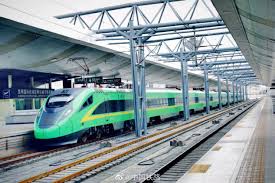Recently, the railway container terminal at Wangjiaying West station, Kunming, southwest China’s Yunnan province, has become super busy.
Gigantic crane arms are hoisting fully loaded containers onto freight trains, and numerous commodities are being shipped to Vientiane from the terminal along the newly opened China-Laos Railway, including vegetables, flowers, daily necessities, and mechanical and electrical products.
The China-Laos Railway, bringing closer Kunming and Vientiane, has expanded new space for social and economic development of China and Laos.
The China-Laos Railway is a flagship project of China-Laos mutually beneficial cooperation. Since it was opened, both cargo and passenger services have been on a huge demand, which indicates that the project, facilitating the production and lives of the people along the route and boosting local economic development, is creating new opportunities.
As a signature project of the high-quality construction of the Belt and Road, the China-Laos Railway, upon completion, is enhancing the bond between the Chinese people and the Lao people with enhanced infrastructure. It has put an end to the history when Yunnan’s Pu’er and Xishuangbanna were not connected to rail service, and brought a modern railway to the people in Laos, making trips much easier for the people along the route.
In the past month and more, an average of 23.5 pairs of passenger trains were put into operation on a daily basis, with the single-day highest reaching 31.5. A total of 700,000 passengers took the rail service during this period of time, and around 75,000 of them were outside China.
During the New Year holiday, a new pair of bullet trains running between Vientiane and Boten were put into operation to meet the transportation demand of the Lao people.
Offering safe and convenient services, the China-Laos Railway is favored by both Chinese and foreign passengers. It is enhancing people’s welfare and contributing to regional prosperity.
The China-Laos Railway has built an economic corridor connecting the Chinese market and Southeast Asia and South Asia, shaping a new pattern of opening-up with Kunming as the center, which docks with the new western land-sea corridor in the east, the Bangladesh-China-India-Myanmar Economic Corridor in the west, ASEAN countries in the south and the Chengdu-Chongqing economic circle in the north.
As of Jan. 17, Kunming customs had inspected and green-lighted 153 international trains running on the China-Laos Railway, which carried 59,500 metric tons of cargos with a total value of nearly 1.07 billion yuan ($169 million). The railway has forged a transportation network that covers nine Chinese provinces, as well as 10 countries joining the Belt and Road Initiative. It means that to some extent, the China-Laos Railway is gradually driving regional connectivity.
Today, it takes as short as only 26 hours for cargo trains to arrive in Vientiane from Kunming. The low-cost and efficient transportation is injecting new impetus into regional development.
As the starting point of the China-Laos Railway, Yunnan province has been taking advantages of its regional features to grasp opportunities. It has accelerated the development of the warehousing, logistics, cold-chain transport and green food manufacturing industries, further optimized the industrial structure along the rail route and strengthened industrial support, so as to integrate itself deeper into the cross-border industrial chain, supply chain and value chain facing the Southeast Asian and South Asian market and to build a new engine for high-quality opening-up and development.
It is believed that, with the official implementation of the Regional Comprehensive Economic Partnership, the China-Laos Railway will become an even bigger catalyzer for regional economy and better serve the construction of the Belt and Road.


